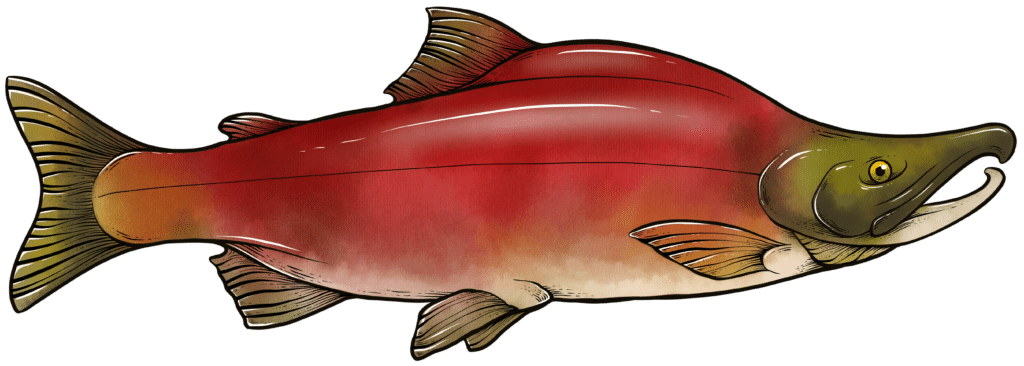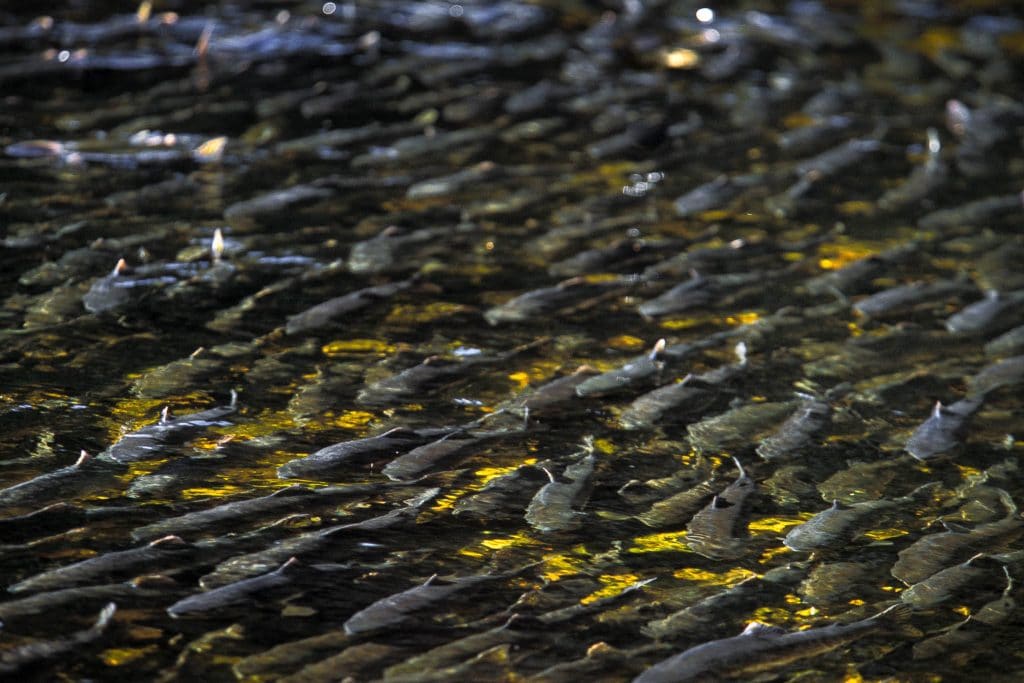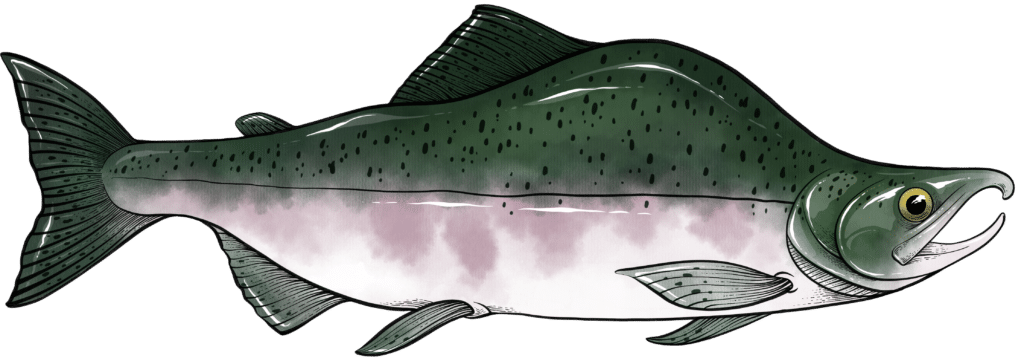When we advocate for enhanced protections for wild salmon, critics often assert that these measures are unwarranted, citing a rise in overall salmon populations in the ocean. Yet, how can this claim hold true amidst wide-range reports highlighting major decline of salmon runs? The reality, as often is the case, is more nuanced and complex. Indeed, long-term trends in salmon populations reveal an intriguing insight: wild salmon in the North Pacific Ocean are at their highest levels in decades. While this may seem like a triumph for salmon conservation, is more always better?
Trends in salmon populations show that pink and chum salmon are above long-term averages, sockeye are within long term averages, and coho and Chinook are below long-term averages. But, this data is also broad scale, and there is much more to the story when you look at a regional level.


Chum and Sockeye Salmon Illustrations by Claire Watson
Population numbers differ greatly for many reasons, including proximity to human activity (industrial development, fisheries, etc.). In particular, pink salmon populations are inflated by hatchery production in the North Pacific Ocean. The primary purposes of hatcheries is to artificially augment the number of “wild” salmon available for commercial and recreational harvest and to compensate for habitat destruction and lost natural production. As pink salmon originating from hatcheries start to outnumber wild populations, they outcompete salmon and non-salmon species to a capacity that threatens the health of marine ecosystems. Here, we investigate how having an influx of pink salmon from hatcheries may be doing more harm than good for marine biodiversity.
Historical Context
Analysis of commercial catch and escapement data over a 90-year period reveals that some Pacific salmon species are twice as abundant as they were fifty years ago while others continue to decline.The Pacific region surrounding British Columbia (B.C.) is home to five species of salmon: pink, chum, sockeye, coho, and Chinook. Historically, pink, chum, and sockeye are the most abundant salmon species. Currently, pink are most abundant (67% of the three), followed by chum (20%) and then sockeye (13%). Pink, chum, and sockeye salmon populations are considered stable or are increasing while Chinook and coho salmon continue to see significant declines.
Since overexploitation and disruptions to marine ecosystems started many decades before the first quantitative stock assessments, researchers can only speculate what historic salmon populations were once like. Archeological records of the remains of salmon harvested by Indigenous peoples in the Pacific Northwest identify salmon as the most harvested fish resource of the last 7,500 years. Researchers in one study suggest that these records indicate a stable population up until 130 years ago through sustainable traditional fisheries. Indigenous fishing management technologies – including dip nets, fish traps, and weirs – are part of the selective fishing practices that sustained healthy salmon populations for millenia.

Since colonization, populations of Pacific salmon have suffered and changed dramatically due to overexploitation from commercial harvesting methods and, more recently, climate change. Today, traditional knowledge keepers attribute recent declines in salmon populations to commercial fishing, but also to open-net pen aquaculture, climate change, contaminants, industrial development, infectious diseases, and parasites (sea lice). Given that salmon are a vital ecological and cultural foundation species, there is serious concern from Indigenous communities about how the decline will change salmon-linked cultural practices, economies, knowledge, and coastal community well-being.
Despite pink salmon being documented at record-level highs, hatcheries (primarily in Alaska and Russia) continue to release an estimated 1.4 billion pink salmon per year. The unique two-year life cycle pattern of pink salmon makes them a cost-effective option for hatcheries, however, the abundance of hatchery salmon can affect the genetic composition and reproductive success of wild salmon. As such, there is concern that pink salmon from hatcheries may be weakening the gene pools of their wild counterparts while overconsuming the resources that are shared with other salmon and non-salmon species. It remains an open debate if the negative impacts of pink salmon released by hatcheries are an acceptable exchange for the rewards benefiting socioeconomic needs.
Why is growth in pink salmon abundance an issue?

Pink salmon (Oncorhynchus gorbuscha) play a key role in predator-prey dynamics across different niches in marine ecosystems. Being opportunistic feeders, pink salmon consume a wide variety of prey, including zooplankton, smaller fish, and invertebrates. This flexibility allows them to thrive in diverse environments, but their large and increasing numbers are disruptive to ecological balance in several ways:
- Predator-prey imbalance:
Upon entering the ocean in the spring and summer, pink salmon consume a diet of large zooplankton. Zooplankton are small animals that feed largely on phytoplankton and, in turn, provide a vital food source for larger animals. In the years where there is an influx of pink salmon, zooplankton populations decrease significantly, and phytoplankton populations, in turn, increase. In the years where pink salmon are less abundant, zooplankton populations are larger, and phytoplankton populations are depleted. In all cases, variations in pink salmon populations are dramatically reflected in prey populations. With this highly consumptive relationship in place, the question remains: Is what is remaining of zooplankton populations sufficient for supporting other marine species? - Impact on Forage Fish:
A loss of zooplankton populations is disruptive to food webs because zooplankton are a key energy source for species like forage fish (e.g. herring, sardines, mackerel, sand lance). This is highlighted in recent studies where a negative correlation is observed between the weight (and therefore nutrient quality) of forage fish and pink salmon abundance. These changes radiate throughout the food web, creating an ecosystem-wide cascading effect, as forage fish are a critical food source for marine birds, diverse fish species, and marine mammals. - Salmon-Species Competition:
As pink salmon grow and mature, they begin to consume larger prey with high nutritional value, like squid. These feeding behaviors are directly competitive with species that also require high-quality prey to meet their metabolic needs, including Chinook salmon. As high-quality prey drives energy flow throughout the food web, the salmon species being outcompeted by the influx of hatchery pink salmon must work harder to meet their energy requirements. The losses from these competitive pressures can be detrimental to maturation, productivity, and survival rates.
The Decline of Chinook Salmon
Chinook salmon are known indicators for salmon management in the Pacific Northwest. Their current declines are mostly driven by ocean warming and habitat loss. Chinook face a broad suite of natural and human-driven pressures while competition with pink salmon further weakens resilience to these pressures. In contrast, pink salmon are known for responding quickly to ecosystem change due to their short two year lifecycle. Pink salmon are also smaller and have less energy requirements in a warming ocean compared to the larger salmon species.
As pink salmon from hatcheries influence the decline in wild salmon populations – including wild pink salmon, Chinook are no exception. Some studies suggest that the abundance and size of adult wild Chinook salmon are negatively correlated with pink salmon abundance. This is likely because pink salmon share considerable competition as predators, but are more efficient at prey consumption compared to Chinook. So, when prey is a limited resource, the inputs of pink salmon from hatcheries cause pink salmon populations to increase and the competition causes Chinook populations to decrease in size and numbers.
Chinook salmon are particularly critical as the primary prey of the Salish Sea’s endangered Southern Resident Killer Whale (SRKW) population. Because SRKW are size-selective, Chinook are favored for their size and high fat content, and small pink salmon do not make for a suitable substitute long-term. While SRKW populations declined by 20% from 1998 to 2020, pink escapement to rivers increased by 135% in the Salish sea. One study observed that in years where pink salmon were abundant, the average physical health for SRKW was lower. Similarly, in the year following the years where pink salmon were less abundant, SRKW populations saw more successful birth rates and fewer deaths.

From 1998 to 2020, the SRKW population had 46 fewer individuals (19-65 animals) in the years immediately following a year with high pink salmon abundance. These populations increased by 12 individuals (33-21 animals) immediately following a year with low pink salmon abundance.
As their primary prey, Chinook salmon populations are intimately linked to the health of SRKWs as is noise pollution and contaminants. If pink salmon populations outcompete Chinook salmon, this affects SRKW populations. It is also possible that the influx of pink salmon interferes with SRKW foraging efficiency of Chinook salmon. Ultimately, there is a clear need to better understand the interactions pink salmon have in the food web to enhance SRKW recovery plans and better mitigate changes driven by hatcheries.
Implications
The influx of pink salmon underscores the urgent need to understand the mechanisms affecting survival of myriad species in the ocean. It also calls for an integrated reassessment of hatchery and wild salmon management.
With hatchery salmon pushing the boundaries of the salmon-carrying capacity of the Pacific Ocean, entire food webs are disrupted and ecosystem health is compromised. Changes in the productivity and reproductive health of wild salmon due to hatchery fish may wear down their resilience, and jeopardize their ability to withstand additional environmental or human-induced stressors.

Biodiversity is crucial for maintaining the ecosystem services that support life on this planet – clean water, food security, and climate regulation. Declines in biodiversity deteriorate ecosystem stability and resilience, and can lead to the collapse of these ecosystems and the communities that depend on them.
Ultimately, shifts in salmon ecology threaten biodiversity, which in turn threaten our own well-being. As recognized by Indigenous and coastal communities, human health is inextricably linked to the health of the waters that surround us and the salmon that call these places home; they are one and the same.
hishuk’ish tsawalk – everything is connected, everything is one
Nuu-chah-nulth teaching
References
Batten, S., Ruggerone, G., & Ortiz, I. (2018). Pink salmon induce a trophic cascade in plankton populations in the southern Bering Sea and around the Aleutian Islands. Fisheries Oceanography, 27(5), 548–559.
Crozier, L. G., Burke, B. J., Chasco, B. E., Widener, D. L., & Zabel, R. W. (2021). Climate change threatens Chinook salmon throughout their life cycle. Communications Biology, 4, 222.
Dedrick, A. G., & Baskett, M. L. (2018). Integrating genetic and demographic effects of connectivity on population stability: The case of hatchery trucking in salmon. The American Naturalist, 192(2).
Losee, J., Kendall, N., & Dufault, A. (2019). Changing salmon: An analysis of body mass, abundance, survival, and productivity trends across 45 years in Puget Sound. Fish and Fisheries, 00, 1–18.
May, S., et al. (2024). Salmon hatchery strays can demographically boost wild populations at the cost of diversity: Quantitative genetic modeling of Alaskan pink salmon. Royal Society Open Science, 11, 240455.
Ohlberger, J., et al. (2022). Non-stationary and interactive effects of climate and competition on pink salmon productivity. Global Change Biology, 28, 2026–2040.
Rand, P., & Ruggerone, G. (2024). Biennial patterns in Alaskan sockeye salmon ocean growth are associated with pink salmon abundance in the Alaska and the Bering Sea. ICES Journal of Marine Science, 81(4), 701–709.
Reid, A., Young, N., Hinch, S., & Cooke, S. (2022). Learning from indigenous knowledge holders on the state and future of wild Pacific salmon. FACETS, 7, 718–740.
Ruggerone, G., Springer, A., Vliet, G., Connors, B., Irvine, J., Shaul, L., Sloat, M., & Atlas, W. (2023). From diatoms to killer whales: Impacts of pink salmon on North Pacific ecosystems. Marine Ecology Progress Series, 719, 1–40.
Ruggerone, G., & Irvine, J. (2018). Numbers and biomass of natural and hatchery origin pink salmon, chum salmon, and sockeye salmon in the North Pacific Ocean, 1925–2015. Marine and Coastal Fisheries: Dynamics, Management, and Ecosystem Science, 10, 152–168.
Saygili, B., Trites, A. (2024). Prevalence of Chinook salmon is higher for southern than for northern resident killer whales in summer hot-spot feeding areas. PloS one
Shiomoto, A., Tadokoro, K., Nagasawa, K., & Ishida, Y. (1997). Trophic relations in the subarctic North Pacific ecosystem: Possible feeding effect from pink salmon. Marine Ecology Progress Series, 150, 75–85.
Wells, B., et al. (2020). Implementing ecosystem-based management principles in the design of a salmon ocean ecology program. Marine Ecosystem Ecology, 7.
